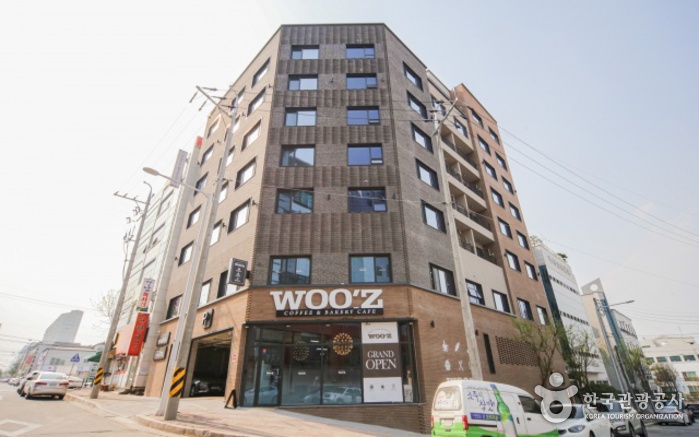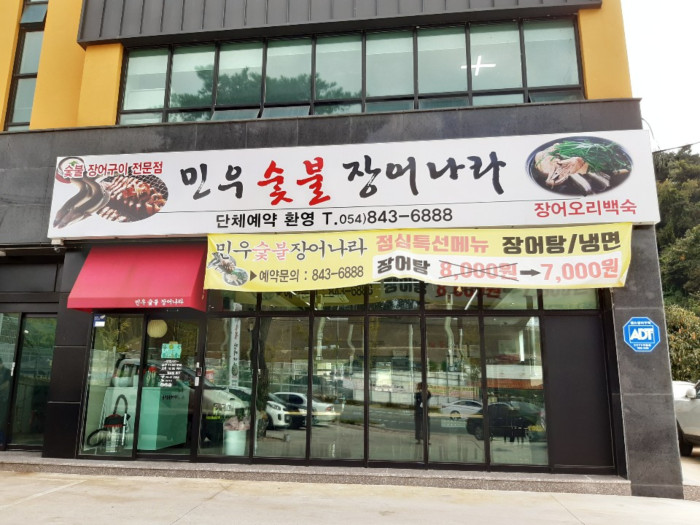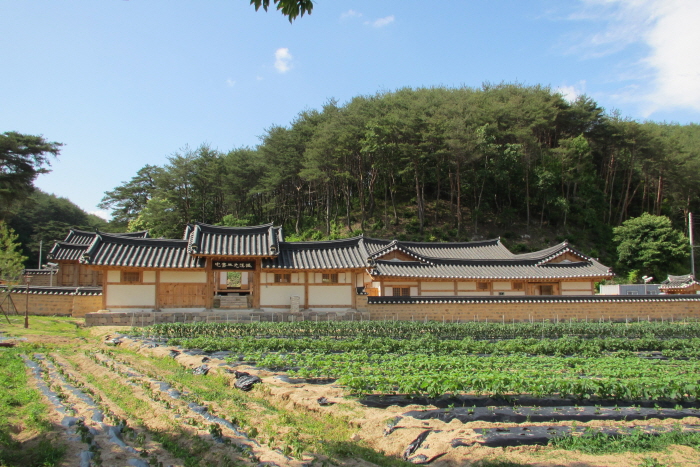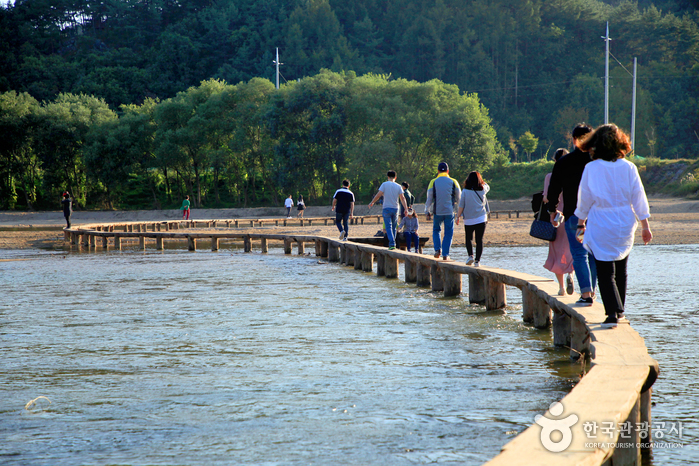Temple Bongjeongsa [Patrimoie de l'UNESCO] (봉정사[유네스코 세계유산])
9.4Km 2023-05-23
222, Bongjeongsa-gil, Andong-si, Gyeongsangbuk-do
+82-54-853-4181
Le temple Bongjeongsa a été construit par le moine Uisang durant la 12ème année de règne du roi Munmu (règne de 661~681) de la dynastie Silla. Le temple Bongjeongsa est le plus grand temple à Andong, il possède le bâtiment le plus ancien en Corée, le pavillon Geungnakjeon. Certains documents anciens affirment que Neungin Daedeuk, un disciple du moine Uisang, est à l'origine de la création du temple.
Parc Grasswon (그라스원)
9.5Km 2023-07-10
273, Yuksa-ro, Andong-si, Gyeongsangbuk-do
Le parc Grasswon se situe sur les bords du fleuve Nakdonggang dans la ville de Andong. Le site, réputé pour son pont Yeonggadaegyo, propose des sentiers de promenade dans une belle nature. Le site est particulièrement réputé en automne. Il est possible de rejoindre le parc Baekjo depuis les lieux faisant de l'endroit un endroit recommandé pour découvrir le fleuve Nakdonggang.
Kase Hotel (formerly Andong Kase)/ 케이스호텔((주)안동케이스)
10.2Km 2025-08-13
60-16, Gangnam 2-gil, Andong-si, Gyeongsangbuk-do
+82-54-857-0007
This 8-story hotel is located about 15 min by car from Andong Station and Andong Terminal. Its riverside location at Nakdonggang River offers guests an opportunity to take a walk along the river. There are 42 rooms in total, in seven types, all furnished with elegance in mind with low-saturation walls, gray curtain, and gold-framed furniture. All rooms have Netflix streaming access. Family Room, Suite Party Room, and Luxury Party Rooms have refrigerators, induction stoves, microwave ovens, and kitchen sinks for cooking. These rooms also have a mini swimming pool for children, making them especially popular in summer. Luxury Party Room, which can accommodate up to 8 guests, has a living room separated from the bedroom, allowing easier management of space. Both rooms also have a TV. Andong’s tourist sites, such as Imcheonggak House, which is Treasure No. 182 of Korea, Andong Jjimdak Alley, and Woryeonggyo Bridge is reachable by car in 10 min.
Minu Sutbul Jangeo Nara(민우숯불장어나라)
11.4Km 2025-08-01
24, Gwangmyeong-ro, Andong-si, Gyeongsangbuk-do
+82-54-843-6888
This is a place where you can enjoy healthy eel dishes. The best menu at this restaurant is grilled eel. This Korean dishes restaurant is located in Andong-si, Gyeongsangbuk-do.
Ecole confucianiste Dosanseowon [Patrimoine Mondial de l'UNESCO] (도산서원)
11.9Km 2023-05-23
154, Dosanseowon-gil, Andong-si, Gyeongsangbuk-do
+82-54-852-6800
L’école confucéenne Dosanseowon a été établie en 1574 (7ème année du règne du roi Seonjo), par des disciples des mémoires du premier Lee Hwang.
La salle de conférence Dosan désigne une ancienne académie où Lee Hwang enseignait les études académiques. En 1574 (la 7ème année du règne du roi Seonjo (1567~1608) de la dynastie Joseon (1392~1910)), des érudits confucéens et d’autres lettrés ont inauguré un lieu saint appelé Sangdeoksa. En 1969, il a été désigné comme trésor national Nº 170. Après avoir placé l'espace funéraire et offert les rites sacrificiels, la salle de conférence a été terminé avec la construction de Jeongyodang (Trésor National Nº 210) ainsi que les ailes ouest / est (lieu d'étude pour les savants).
Lorsque vous entrez par l’entrée principale, vous trouverez la salle de conférence Dosan sur votre droite. La structure du bâtiment est simple avec des pilliers carrés et des poutrelles insérées dans les traverses. Si vous continuez plus loin derrière la salle de conférence en passant par la porte Jindomun, vous trouverez la salle Gwangmyeongsil où sont gardés des livres anciens. Vous trouverez également le bâtiment principal Jeongyodang et les ailes ouest / est.
Derrière Jeongyodang, on trouve le lieu saint Sangdeoksa, Jangpangak ainsi qu’un arbre où sont imprimés les ‘12 Chants de Dosan’. Le pavillon Okjingak, qui a été reconstruit en 1970, est désormais un bâtiment d’exposition des reliques de Toegye.
On-gye Jongtaeg (Sambaegdang) / 온계종택 삼백당
13.7Km 2025-03-04
20, Onhyejungma-gil, Andong-si, Gyeongsangbuk-do
+82-10-2988-3435
Ongyejongtaek Sambaekdang is a hanok restored on the site where Ongye Yihae, older brother of Toegye Yi Hwang, used to live. Being the headquarters of the rightoue army against the Japanese, the house was burned by the Japanese military authority in 1896 but restored with support from the government and others, and it was finally completed in May 2011. It is the 500-year old chestnut tree, symbol of the village, which welcomes guests first. The house itself is not old but the atmosphere of the family dominates the building with dignity. Small decorations such as a wooden table, floor cushions, and mother-of-pearl furniture pieces are all nice to look at. There are 7 rooms altogether with bathrooms or air conditioners depending on the room size. There are a shared shower facility and a laundromat outside the rooms, with shared kitchen, warehouse, and a big floor. Cooking is not allowed in the rooms but outdoor barbecue facilities are available for a group of 10 or more who inquire in advance. Tea ware pouch making or Hanji craft programs are conducted based on the reservation at a charge. In the village where the house is located, there are several historic and natural sites such as Nosongjeongjongtaek where Toegye Yihwang was born, Nongamjongtaek, Toegyejongtaek, Dosanseowon Confucian Academy, Advanced Center for Korean Studies, Cheongryangsa Temple, and Dosan Spa.
La Forêt Hakgasan Urae (학가산자연휴양림)
15.8Km 2020-12-08
San 60, Urae-ri, Bomun-myeon, Yecheon-gun, Gyeongsangbuk-do
+82-54-652-0114
La forêt Hakgasan Urae est située au mont Hakgasan (882 mètres d'altitude) à Yecheon dans la province de Gyeongsangbuk-do. Elle est facilement accessible par la route qui longe la rivière.
Vous y trouverez des cabanes en bois pour y passer la nuit. Un sentier mène au sommet du Mont Kakgasan à environ deux heures de marche. On y trouve aussi un site pour le feu de camp, une scène de spectacle, un terrain de jeu pour enfants, une salle de sport et un parc aquatique.
Village de Museom à Yeongju (영주 무섬마을)
16.2Km 2021-05-25
31-12, Museom-ro 234beon-gil, Yeongju-si, Gyeongsangbuk-do
+82-54-638-1127
Situé à Sudo-ri (Munsu-myeon, Yeongju, province du Gyeongsangbuk-do), le village de Museom est une charmante bourgade de hanok entouré d’eau. Les rivières de Naeseongcheon et de Yeongjuchon prennent leur source aux monts Sobaek et Taebaek, et convergent vers le village de Museom, l’entourant d’eau par trois côtés. Ce village semblable à une île est non seulement un haut lieu de la culture traditionnelle coréenne, mais il possède également un environnement naturel splendide, complété par une grande plage de sable et une forêt luxuriante.
Célèbre pour les maisons Haeudang et Manjukje (deux des hanoks les plus historiques de la région), le village est également connu pour ses exceptionnelles maisons traditionnelles comme la maison de Kim Gyu-jin et la maison de Kim Wi-jin. Manjukje est située au coeur du village, et elle est également appréciée par les visiteurs internationaux comme étant la plus ancienne maison traditionnelle du village de hanok. Manjukje a été construite en 1666 (lors de la 7ème année du règne du roi Heonjong) par Bak Su (le patriarche de la famille Bak de Bannam).
Près de Manjukje se trouve la maison Manun, construite au début du XIXème siècle et baptisée d’après Kim Hwi-geol, dont le nom de plume est « Manun ». La maison est devenue plus tard la résidence de l’épouse du célèbre poète Jo Ji-hun, auteur de « Byeolli », un poème exprimant la beauté du village de Museom.
Parmi les autres maisons notables, on peut citer celle de Kim Jin-wi (une maison appartenant à des aristocrates), celle de Kim Jeong-gyu (une maison dépourvue de la clôture extérieure traditionnelle) et celle de Jae-yeon, où les écrits de Bak Gyu-su (lettré appartenant à l’école de pensée Silhakpa à la fin de la dynastie Joseon) se trouvent encore aujourd’hui.
Le Pont de l’Unique Rondin constitue une autre attraction du village. Ce pont a représenté le seul lien avec le monde extérieur pendant plus de 250 ans, avant la construction du pont de Sudo en 1979. Il est minuscule en largeur (30 cm) mais On dit qu’il était reconstruit chaque année après avoir été détruit à chaque saison des pluies. Avec la construction du pont de Sudo, le Pont de l’Unique Rondin était inutile, mais il a été reconstruit quelques temps après sous sa forme originale. Pour rendre hommage à l’histoire impressionante du pont, le festival Oeinamu Dari (qui signifie Festival du Pont de l’Unique Rondin) a lieu tous les jours en octobre.
Jeongjae Head House / 정재종택
16.2Km 2025-08-12
경상북도 안동시 임동면 경동로 2661-8
+82-10-8590-0625
Boasting more than 300 years of tradition, Jeongjae Traditional House is the head house of Ryu Chi-myeong (pen-name: Jeongjae), who inherited the study of Togye Yi Hwang (1501-1570), one of the two most prominent Korean Confucian scholars of Joseon. The old house features the characteristic construction elements of a Joseon hanok, including the stylobate, wooden pillars, toenmaru (the narrow wooden porch running along the outside of the building), tiled roof, and other structures, and commands an open view of Imha Lake. The house was originally built by Ryu Gwan-hyeon, the great-great-grandfather of Ryu Chi-myeong, in 1735 (the 11th year of the reign of King Yeongjo of Joseon) in the village of Handeul in Imdong-myeon, Andong-si, Gyeongsangbuk-do, but it was relocated to the foot of Guamsan Mountain in 1987 when Imha Dam was built and the surrounding area was submerged as a result. The house consists of the daemunchae (gate building), jeongchim (a ‘ㅁ’-shaped house with a tiled roof), haengnangchae (servants’ quarters), a shrine, and a pavilion. The sarangchae (men’s quarters) is clearly visible, while the anchae (women’s quarters) is concealed within the house. The sarangchae has a sarangmaru (wooden floor), a large sarangbang room, a small sarangbang room, and there is a small maru between the two rooms. The buildings of the sarangchae and anchae are clearly divided into segregated spaces for men and women according to Confucian tradition. The anchae has a daecheongmaru (large wooden floor) in the middle; a main room, kitchen, and toilet on the right; and a numaru (upper floor) and sangbang (upper room) on the left. The small side door of the main gate links to the door by which to enter the anchae, which has a small vegetable garden. Manujeong Pavilion (Gyeongsangbuk-do Cultural Heritage Material No. 37) is a half-hipped roof building with single-layered eaves located on the left side of the house outside the main gate. It is the place where Ryu Chi-myeong used to teach his students, and consists of a large maru and a guest room. The pavilion is also surrounded by the beautiful scenery of Imha Lake, mountains, and chestnut trees. Jeongjae Traditional House provides two special experience programs: Making Songhwaju, which is the Ryu family’s home-brewed liquor (15 to 18 degrees) made with rice, glutinous rice, yeast, pine needles, and chrysanthemums, led by the owner’s wife (Intangible Cultural Asset No. 20); and Making Tarak, which is a fermented milk drink that has been made by the Ryu’s family for some 500 years. As the recipe for making Tarak is relatively simple, and uses yeast that is usually used to make raw rice wine like Makgeolli, people can easily make it at home. The house also runs a traditional music program designed to show participants how to play the gayageum (Korean zither with twelve strings) and sing Korean folk songs, and stages small concerts.
Oryuheon House / 오류헌
16.2Km 2025-08-12
18-15, Gireumaje-gil, Andong-si, Gyeongsangbuk-do
Oryuheon House, located near Imhaho Lake in Andong, Gyeongsangbuk-do, offers a chance to stay in a historic house from the Joseon period. The house, also known as Mogwa House, was built by Kim Won-jung, the third son of Sukjong-era rector of the National Academy Kim Bang-geol, when he formed a family of his own in 1678. It was designated as the National Folk Cultural Heritage No. 184. The door’s wooden frame and the open floor space exemplify the beauty of the literati house of the Joseon period, while the sarangchae (men’s quarters) and daemunchae (gate quarters) showcase the sophisticated architecture of the era. Anchae (women’s quarters) retains its original appearance, while the sarangchae was rebuilt in 1920. The construction of the Imha Dam in 1990 resulted in the house’s relocation to its present location.
The owner of the house resides in anchae and sarangchae. Guests have access to a space that includes a 2-kan room, which can accommodate up to 4, an open floor space, and a bathroom. Cooking is prohibited in the house, but guests can make use of a grill located on a small yard reserved for the guests. Korean-style breakfast, including menus like chicken porridge or lotus leaf rice, are offered free of charge in the morning. Nearby sights include the water sports activities in Imhaho Lake, Manhyujeong Pavilion, Hahoe Village, and Dosanseowon Confucian Academy.
![Temple Bongjeongsa [Patrimoie de l'UNESCO] (봉정사[유네스코 세계유산])](http://tong.visitkorea.or.kr/cms/resource/16/2654216_image2_1.jpg)








 Français
Français
 한국어
한국어 English
English 日本語
日本語 中文(简体)
中文(简体) Deutsch
Deutsch Español
Español Русский
Русский